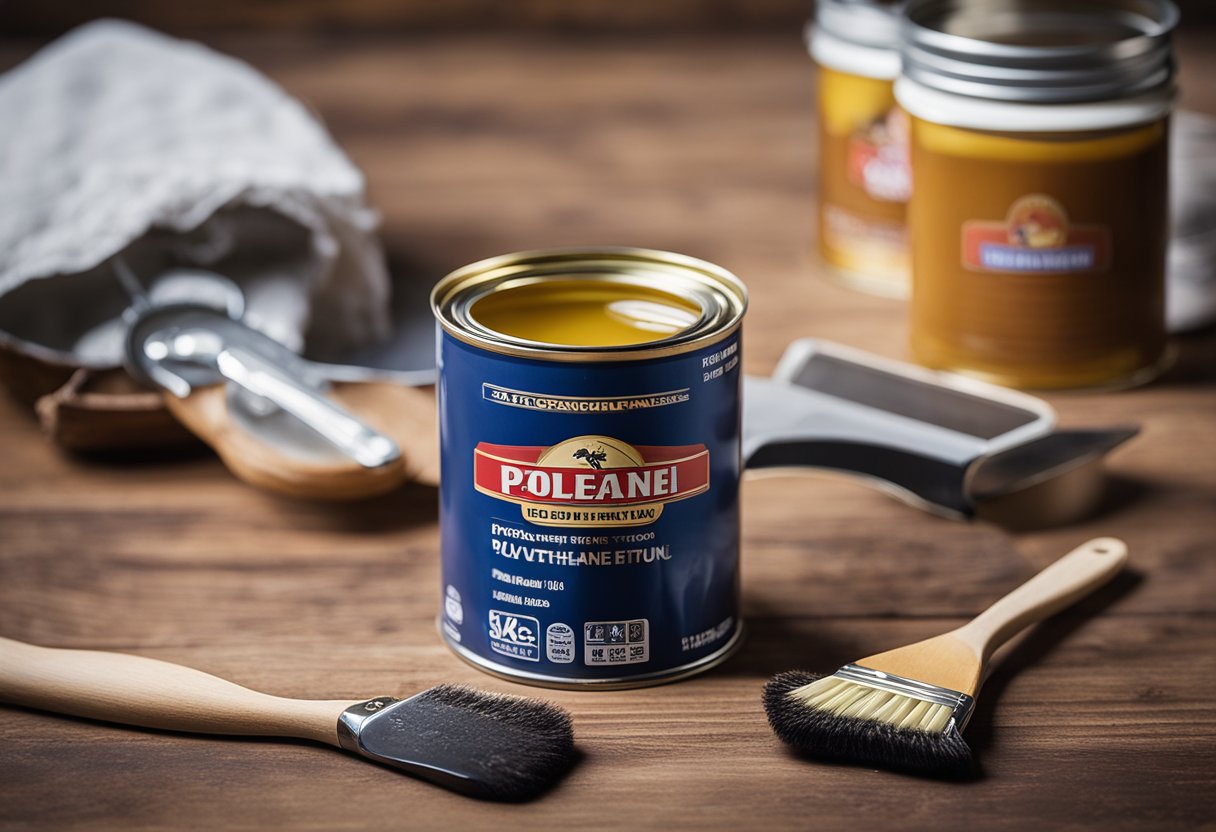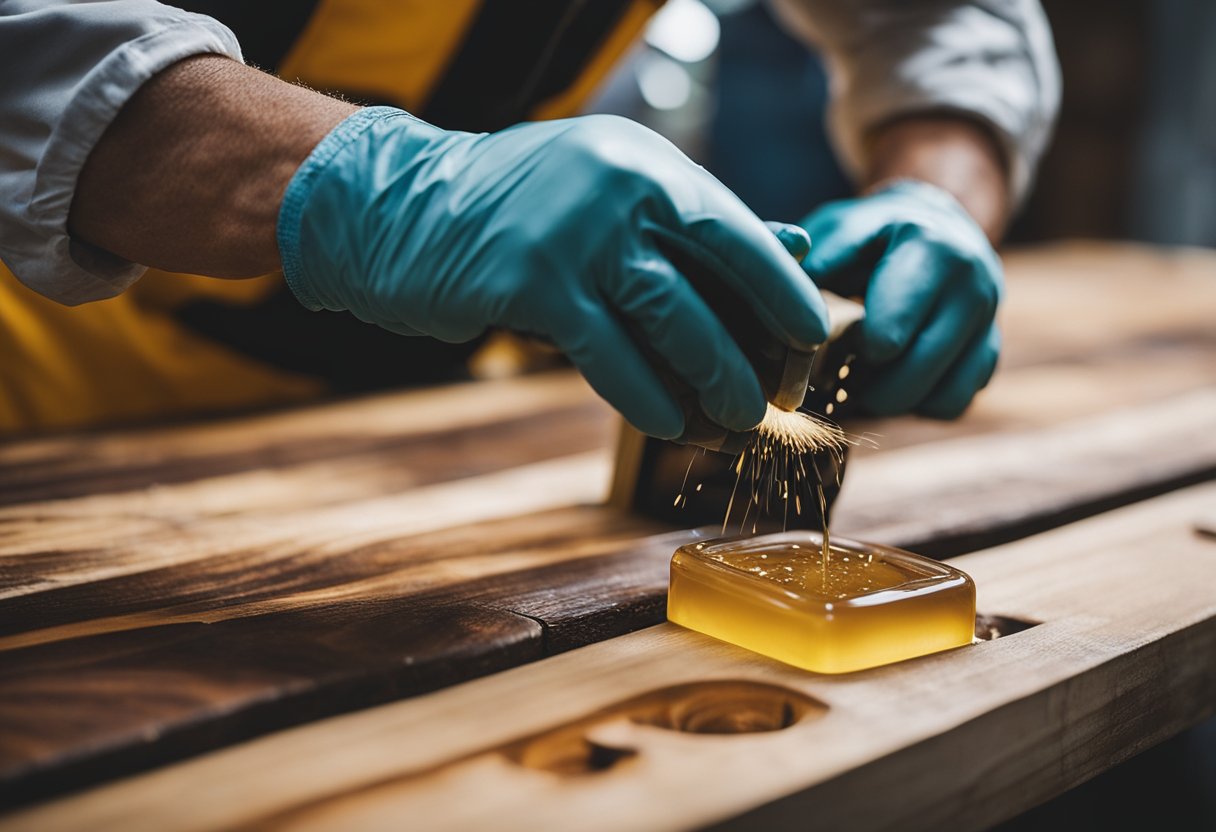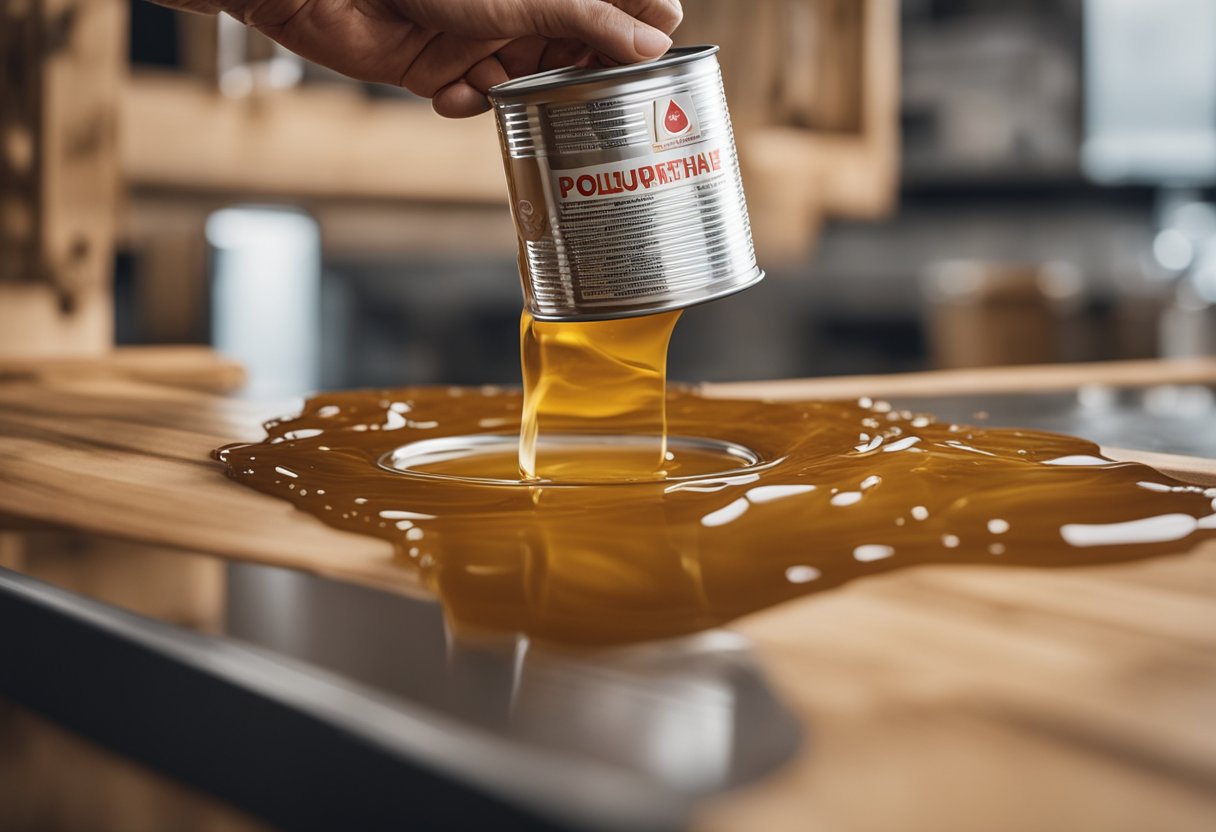I have researched the topic of applying polyurethane over tung oil and have gathered valuable information to share. Polyurethane is a synthetic resin that is commonly used as a protective coating for wood surfaces. Tung oil, on the other hand, is a natural drying oil that is derived from the seeds of the tung tree.
When applied correctly, tung oil can provide a beautiful, natural finish to wood surfaces. However, it may not offer the same level of protection as polyurethane. This is where the combination of tung oil and polyurethane comes in. By applying polyurethane over tung oil, you can create a durable and protective coating that enhances the natural beauty of the wood.
In this article, I will provide a step-by-step guide on how to apply polyurethane over tung oil, as well as tips for preparation, application, finishing, and aftercare. I will also address common troubleshooting and safety considerations, and answer frequently asked questions about this topic.
Key Takeaways
- Applying polyurethane over tung oil creates a durable and protective coating for wood surfaces.
- Proper preparation, application, finishing, and aftercare are essential for achieving the best results.
- By following a step-by-step guide and taking necessary safety precautions, you can successfully apply polyurethane over tung oil to enhance the natural beauty and protection of wood surfaces.
Understanding Tung Oil and Polyurethane
https://www.youtube.com/watch?v=bsjnRcmC840&embed=true
As a wood finish, tung oil has been used for centuries because of its natural beauty and durability. It is extracted from the nuts of the tung tree and is known for its ability to enhance the wood grain pattern while providing a natural finish.
Polyurethane, on the other hand, is a synthetic finish that is widely used because of its durability and resistance to wear and tear. It is available in both water-based and oil-based formulations, and it is known for its ability to provide a hard and protective coating to wood surfaces.
While tung oil and polyurethane are both wood finishes, they have distinct properties and characteristics. Tung oil is a drying oil that penetrates the wood fibers, while polyurethane forms a hard and protective layer on top of the wood surface.
When considering whether to use polyurethane over tung oil, it is important to note that polyurethane will not adhere well to an oiled surface. Therefore, the surface must be cleaned and sanded lightly before application.
In addition, it is important to note that while polyurethane provides a durable finish, it may alter the natural beauty of the wood grain pattern. Therefore, it is important to consider the desired outcome before deciding on which finish to use.
In summary, tung oil and polyurethane are both excellent wood finishes with distinct properties and characteristics. While tung oil provides a natural finish that enhances the wood grain pattern, polyurethane provides a durable and protective coating. When considering whether to use polyurethane over tung oil, it is important to note that the surface must be cleaned and sanded lightly before application.
Preparation for Application
Before applying polyurethane over tung oil, it is essential to prepare the surface properly. Proper preparation ensures that the polyurethane adheres to the surface correctly and provides a durable finish.
The first step is to sand the surface using a fine-grit sandpaper. I prefer using 220-grit sandpaper to sand the surface. Sanding the surface removes any scratches, dirt, or debris that may be present on the surface. After sanding, use a clean cloth to remove any dust or debris left on the surface.
Next, clean the surface using dish soap and water. Mix the dish soap with water and use a clean cloth to clean the surface. After cleaning the surface, rinse it with water and allow it to dry completely.
After drying, use a tack cloth to remove any remaining dust or debris. A tack cloth is a sticky cloth that picks up dust and debris from the surface. It is essential to use a tack cloth before applying polyurethane as any dust or debris left on the surface can cause imperfections in the finish.
It is also important to wear protective gear such as gloves and a respirator when sanding and cleaning the surface. This protects you from inhaling any dust or debris and prevents skin irritation from the cleaning agents.
In summary, before applying polyurethane over tung oil, sand the surface, clean it using dish soap and water, use a tack cloth to remove any remaining dust or debris, and wear protective gear. Taking these steps will ensure that the surface is properly prepared for the application of polyurethane.
Application of Tung Oil
https://www.youtube.com/watch?v=H2nXspdV1_c&embed=true
As a woodworking enthusiast, I have used tung oil finish on several projects and found it to be a durable and beautiful finish for wood. Tung oil is a type of drying oil that penetrates the wood and hardens to form a protective layer. It is a popular choice for finishing furniture, cabinets, and other woodworking projects.
When applying tung oil, it is essential to use thin coats and allow enough drying time between coats. I like to use a foam brush or a soft-bristled brush to apply the oil. The foam brush helps to apply the oil evenly, while the soft-bristled brush helps to work the oil into the wood fibers.
One of the benefits of tung oil is that it can be used on its own as a finish or as a base coat for other finishes, such as polyurethane. It is important to note that tung oil takes a long time to dry and cure. It can take up to 24 hours for each coat to dry, and it may take several weeks for the finish to fully cure.
To ensure the best results when applying polyurethane over tung oil, it is crucial to allow the tung oil finish to cure completely. Applying polyurethane over a still-drying tung oil finish can cause the finish to become cloudy or hazy. I recommend waiting at least a week before applying polyurethane over tung oil.
In conclusion, tung oil is an excellent choice for finishing wood, and it can be used as a base coat for other finishes such as polyurethane. When applying tung oil, it is essential to use thin coats and allow enough drying time between coats. To ensure the best results when applying polyurethane over tung oil, it is crucial to allow the tung oil finish to cure completely.
Applying Polyurethane Over Tung Oil
https://www.youtube.com/watch?v=nxwMmjg4kIY&embed=true
As someone who has worked with wood finishes for a long time, I often get asked whether it is possible to apply polyurethane over tung oil. The answer is yes, you can! However, it is important to note that these two finishes do not combine. Instead, you are applying polyurethane atop tung oil.
Before applying polyurethane over tung oil, it is important to ensure that the tung oil has completely dried. This is because polyurethane will not adhere well to an oiled surface. Once the tung oil has dried, you can lightly sand the surface to ensure that it is clean and free of any debris.
When it comes to choosing a polyurethane finish, you have two options: water-based or oil-based. Water-based polyurethane finishes are generally easier to work with and have a faster drying time. They also have a lower odor and are less likely to yellow over time. Oil-based polyurethane finishes, on the other hand, are more durable and provide a deeper, richer finish.
When applying polyurethane over tung oil, it is important to ensure that the finish is compatible with the tung oil. This means that the polyurethane should be able to adhere to the tung oil without any issues. If you are unsure about compatibility, it is always a good idea to test the finish on a small, inconspicuous area before applying it to the entire surface.
Once you have applied the first coat of polyurethane, you can add additional coats as needed. It is important to note that each coat should be sanded lightly before applying the next coat. This will ensure that the polyurethane adheres properly and provides a smooth, even finish.
In conclusion, applying polyurethane over tung oil is definitely possible and can even increase the durability of your wood finish. Just be sure to follow the proper steps and choose a compatible finish to ensure the best results.
Finishing and Aftercare
https://www.youtube.com/watch?v=7uoZSWof2DM&embed=true
When it comes to finishing wood with tung oil, it is important to know that it is not a protective layer on its own. Applying polyurethane over tung oil can provide a glossy finish and a protective barrier to the wood. It is a good idea to use a satin or semi-gloss top coat to avoid a high gloss finish.
Before applying polyurethane, ensure that the tung oil has dried completely. Sand the surface lightly to remove any excess oil and create a rough surface for the polyurethane to bond with. It is important to note that polyurethane will not adhere well to an oiled surface, so it is crucial to sand the surface before application.
Polyurethane provides a protective coating that offers scratch resistance, hardness, and moisture protection to the wood. It is a water-resistant finish that can withstand exposure to liquids and humidity. It is important to ensure that the wood is completely dry before applying polyurethane to avoid trapping moisture in the wood.
To maintain the protective coating, avoid using harsh chemicals or abrasive cleaners that can damage the polyurethane layer. Instead, use a damp cloth to wipe the surface clean and avoid using excessive water. It is also important to avoid placing hot objects directly on the surface to prevent damage to the protective layer.
In conclusion, applying polyurethane over tung oil can provide a protective layer that enhances the beauty of the wood while providing resistance to scratches, hardness, and moisture protection. It is important to follow the proper application and aftercare procedures to ensure the longevity of the finish.
Troubleshooting and Fixes
https://www.youtube.com/watch?v=8P0JjpV-9O4&embed=true
When working with polyurethane over tung oil, there are a few common issues that may arise. Here are some troubleshooting tips and fixes to help you achieve a smooth and flawless finish.
Brush Marks
If you notice brush marks on your finished surface, it could be due to a few factors. First, make sure that you are using a high-quality brush that is appropriate for the type of finish you are applying. Additionally, be sure to apply the finish in thin, even coats, using long, smooth strokes. If you do end up with brush marks, you can lightly sand the surface with fine-grit sandpaper and then apply another coat of finish.
Scratches
If your finished surface becomes scratched, you may be able to fix it without having to strip and reapply the finish. First, clean the surface with a mild detergent and water, and then dry it thoroughly. Next, use a paint scraper or similar tool to gently scrape away any loose or damaged finish. Finally, sand the area lightly with fine-grit sandpaper, and then apply a thin coat of finish using a high-quality brush.
Stripped Coatings
If you need to strip the polyurethane and tung oil coatings from your surface, there are a few options available. One method is to use a chemical stripper, which can be applied to the surface and then scraped away along with the finish. Another option is to use a heat gun or similar tool to soften the finish, and then scrape it away with a paint scraper.
Wood Fibers
If you notice that the finish is raising the wood fibers, causing a rough or fuzzy surface, you can fix this issue by lightly sanding the surface with fine-grit sandpaper. Be sure to sand in the direction of the grain, and then clean the surface thoroughly before applying another coat of finish.
By following these troubleshooting tips and fixes, you can achieve a beautiful and professional-looking finish when using polyurethane over tung oil.
Safety Considerations
When working with polyurethane and tung oil, it is important to take the necessary safety precautions to protect yourself from harm. Here are some safety considerations to keep in mind:
Protective Gear
It is essential to wear protective gear when working with polyurethane and tung oil. These chemicals can be harmful if they come into contact with your skin, eyes, or lungs. Here are some protective gear items to consider:
- Gloves: Wear gloves to protect your hands from the chemicals. Nitrile gloves are a good choice because they are resistant to chemicals and punctures.
- Eye Protection: Wear safety goggles to protect your eyes from splashes and fumes.
- Respirator: Wear a respirator to protect your lungs from the fumes. Make sure the respirator is rated for organic vapors.
Solvent
When working with polyurethane and tung oil, you will need to use a solvent to clean your tools and brushes. Here are some things to keep in mind:
- Ventilation: Make sure you work in a well-ventilated area to avoid inhaling the solvent fumes.
- Proper Disposal: Always dispose of the solvent properly. Do not pour it down the drain or into the trash. Contact your local hazardous waste disposal facility for guidance.
By following these safety considerations, you can ensure that you work with polyurethane and tung oil safely and avoid any harm.
Step-by-Step Guide to Applying Polyurethane Over Tung Oil
I have found that applying polyurethane over tung oil is a great way to protect and enhance the natural beauty of wood. Here is a step-by-step guide on how to do it:
-
Prepare the Surface: Before applying polyurethane over tung oil, it is important to prepare the surface. This involves sanding the surface lightly to remove any excess oil and ensure that the polyurethane adheres correctly to the surface. Use a fine-grit sandpaper, and wipe down the surface with a clean, damp cloth to remove any dust.
-
Clean the Surface: After sanding, it is important to clean the surface thoroughly. Use a mild detergent and warm water to clean the surface, and then rinse it with clean water. Allow the surface to dry completely before proceeding to the next step.
-
Apply the Polyurethane: Once the surface is dry, it is time to apply the polyurethane. Use a high-quality brush or roller to apply a thin, even coat of polyurethane over the tung oil. Be sure to work in the direction of the grain, and avoid over-applying the polyurethane as this can cause bubbles and drips.
-
Let it Dry: After applying the first coat of polyurethane, allow it to dry completely. The drying time can vary depending on the temperature and humidity, so be sure to check the manufacturer’s instructions. Once the first coat is dry, lightly sand the surface with a fine-grit sandpaper, and then wipe it down with a clean, damp cloth to remove any dust.
-
Apply Additional Coats: If desired, apply additional coats of polyurethane following the same process as the first coat. Be sure to allow each coat to dry completely before sanding and applying the next coat.
-
Finish: Once all coats of polyurethane have been applied and have dried completely, the surface will be protected and enhanced. The tung oil will provide a natural, warm glow, while the polyurethane will provide a durable, long-lasting finish.
Overall, applying polyurethane over tung oil is a great way to protect and enhance the natural beauty of wood. By following these simple steps, you can achieve a professional-looking finish that will last for years to come.
Frequently Asked Questions
Is it safe to apply polyurethane over tung oil?
Yes, it is safe to apply polyurethane over tung oil. Both finishes have distinct chemical compositions and qualities that prevent them from completely combining, but they can be used together to create a durable and protective finish. However, it is important to allow the tung oil finish to dry and cure before applying polyurethane.
What are the advantages of using polyurethane over tung oil?
Polyurethane provides an extra layer of protection over tung oil, making it more durable and resistant to water damage, scratches, and discoloration. It also adds a glossy finish that can enhance the natural beauty of the wood.
Can you use Minwax Oil Finish over tung oil?
Yes, Minwax Oil Finish can be used over tung oil. However, it is important to follow the manufacturer’s instructions carefully and allow the tung oil to dry and cure completely before applying the Minwax Oil Finish.
Can you apply Spar urethane over tung oil?
Yes, Spar urethane can be applied over tung oil. However, it is important to allow the tung oil to dry and cure completely before applying Spar urethane. Spar urethane is a good choice for outdoor projects as it provides excellent protection against UV rays and water damage.
How many coats of tung oil should be applied before using polyurethane?
It is recommended to apply at least two coats of tung oil before applying polyurethane. However, the exact number of coats may vary depending on the type of wood and the desired level of protection. It is important to follow the manufacturer’s instructions carefully and allow each coat to dry and cure completely before applying the next one.
What is the best finish to use over tung oil?
The best finish to use over tung oil depends on the specific project and the desired level of protection. Polyurethane and Spar urethane are both good choices as they provide excellent protection against water damage, scratches, and discoloration. However, if a more natural look is desired, tung oil can be used on its own or with a wax finish.

Hi, I’m Sal Muller of Tooltrip.com. My DIY experience led me to understand essential power tools for home projects. Tooltrip.com guides enthusiasts and professionals in choosing right tools for any job. I provide concise top tool reviews for easier, efficient DIY.






